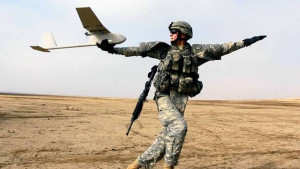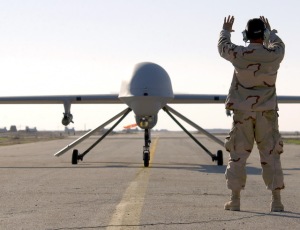
Or is it a mean of avoiding public pressure? After all, no human casualties on the part of the US military involved in using drone attacks—hence, no public pressure. As a matter of fact, according to a report of the Pew Survey, almost 62 percent of the US public approves this strategy of killing people, and only 47 percent of the British people oppose it. But, what then are the intricate dynamics of the US drone war strategy which have made their use more feasible and made the public support it as well?
According to a number of published reports in the Western media, the US policy makers do not bother about the killing of innocent people in drone attacks as long as their aim of targeting their enemies appears to be attainable. For example, according to one of the reports published in 2012 by Patrik Martin, top policy makers object, as result of drone attacks, “not to the violations of international law being carried out by the Obama administration, but to media reports making these violations known to the American people.” Similarly, a report of New York Times provided details about the President Obama’s personal role in approving a “kill list” of targets for the US drone missile strikes. These reports also highlight that the US has established the principle that any military-age male in a target zone may be killed as a presumed terrorist, regardless of his actual status. It must be recognized as well that drones are not merely used for conducting missile strikes. Apart from conducting missile strikes and extra-judicial killings, the US has been an is still extensively using drones for surveillance and espionage.
It should be acknowledged that during the period of the last three decades, the civil culture of the US has gradually been transformed into the societal texture of militarization. What has potentially changed the societal texture of the US society is a combination of two forces: the power-wielding of the ‘Jewish-Christian’ lobby, and the stake holders in the expanding US military industrial complex. During that process, militarization was made to permeate all the segments of the US society, the educational system included. This momentum was carried even further by the aggressive policies being followed by the successive US governments. Starting with the tenure of the US President Bush (senior) and the war mongering first US invasion of Iraq, this process continues to go under the skin of the US society even more deeply. Thus, while the ‘Jewish-Christian’ lobby found its own ideological satisfaction in the destruction of a target ‘enemy country’ ,the stake holders of the military industrial complex started finding a boom in their industry through the additional requirements of weapon-technological advancement and production of the military equipment not only for the US alone but also for the ‘forced sales’ to the countries around the world (e.g., Saudi Arabia was made to accept military purchases from the US worth 50 billion dollars, on the pretext of a still lurking danger from the crippled Iraq as depicted by the US officials).
That momentum was then never lowered by the US President Bush (junior), who on the pretext of the rather mysterious destruction of the twin towers even publicly declared “Crusade”, though he later called it ‘war on terror’. The US invasion of Afghanistan on the well propagated threat to the mainland US from the small Al-Qaeda group in Afghanistan, and a second US invasion of Iraq, with the now proven falsehood of destroying weapons of mass destruction, then followed to keep the US societal militarism strong. Now, the new American President, Mr. Obama has also been following the same policy even with more vigour, finding new pretexts in Libya, Yemen, Somalia, and Pakistan to keep up the momentum of the external military domineering of the US.

This fact of militarization of the US culture is credibly sustained by published data and documents. The brief excerpts from one of the publications should, however, suffice. Jorge Mariscal, in a report called “The Militarization of US Culture” has clarified that the military culture values have been made to permeate the US society by a number of means. He writes, “the incursion of military recruiters and teachings into the public school system is well known. The proliferation of JROTC units in American schools began in the early 1990s and continues today. Television spots, print ads, and websites for all the service branches are sophisticated marketing tools designed to attract young people who are unsure of their future. He further mentions that “in the meantime, billions of dollars for the military-corporate-educational complex ($399 billion for the Pentagon alone according to the administration’s FY2004 Discretionary Budget Request), color-coded “terrorist alerts,” police and “homeland security” raids on immigrant communities, and for FOX news bulletins for even the most mundane Defense Department briefing, all work to create a climate of fear and anxiety that is unprecedented in U.S. history”.
As a matter of fact, in the post-9/11 era, the military-industrial complex has been thoroughly mobilized under the rubric of “privatization” and now goes to war with the Pentagon. With its $80 billion-plus budget, the intelligence bureaucracy has simply exploded, and even the once-civilian CIA, too, has undergone a process of para-militarization and now runs its own “covert” drone wars in Pakistan and elsewhere. In a sense, even the military has been “militarized” because of an extremely enhanced interweaving of foreign policy application through projection of military power, overtly and covertly, as the most viable policy option. Similarly, diplomacy, too, has been militarized. Diplomats work even more closely with the military, while the State Department transforming itself into an unofficial ‘arm of the Pentagon’ as well as of the weapons industry, which the secretary of state, Hillary Clinton, was happy to admit in a speech in Florida in May 2012.
The scale of extreme hatred of masses for the US and its allies is phenomenal in the countries affected by this inhuman and brutal war mongering design; and it is increasing manifold. No wonder that about two-third of the once US-respecting people of Pakistan now hate the US to the extent of considering it as an enemy. The similar hate wave is also surging in other countries of Asia and Africa targeted by the US and its Allies. That is the most dangerous implication – the ‘weapon of mass human hatred’ is far more dangerous than the ‘weapons of mass destruction’.
Salman Rafi Sheikh, research-analyst of International Relations and Pakistan’s foreign and domestic affairs. Exclusively for the online magazine “New Eastern Outlook”.
